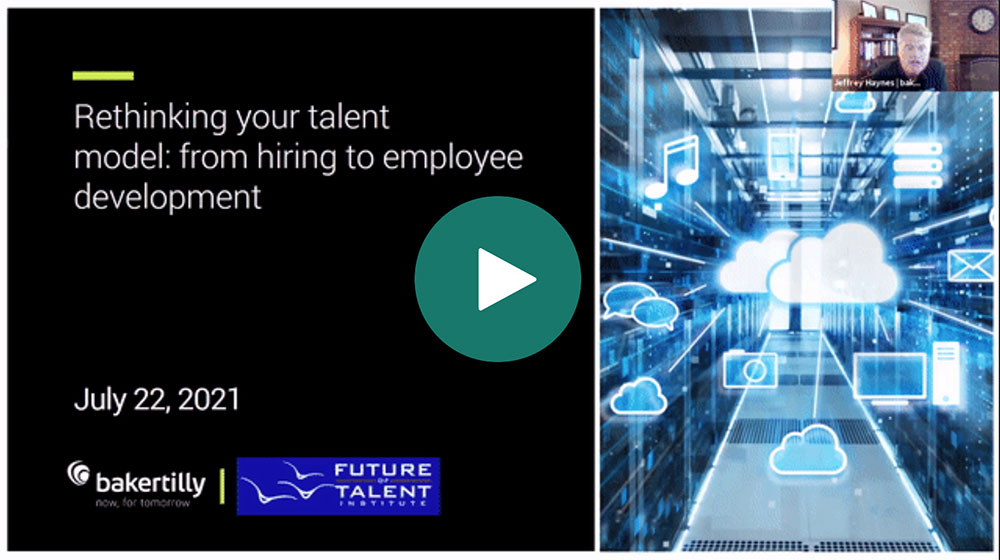
Drive organizational success with the future of talent management
Organizations have struggled for years to develop a model environment where HR, learning and development, and recruitment functions work well together to develop a strong, cross-functional corporate culture around talent. At a recent Baker Tilly hosted webinar, Kevin Wheeler, Founder and President of The Future of Talent Institute, outlined one such model.
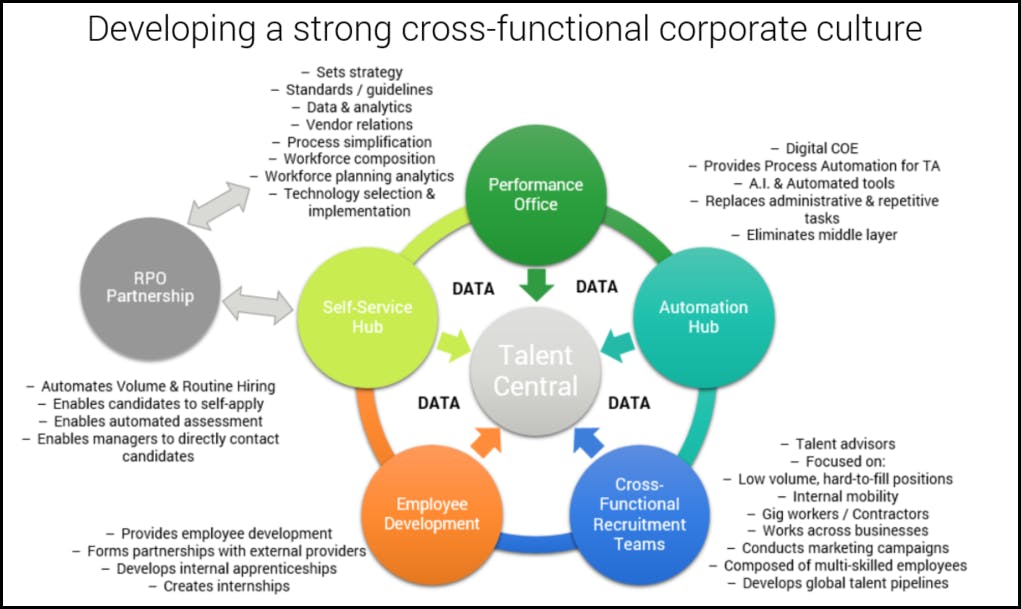
The model features five key functions that:
- Sets a comprehensive, total talent strategy
- Introduces automation into the talent process
- Recruits new employees
- Develops current employees
- Streamlines routine hiring
Under this model, the performance office sets strategy, establishes guidelines and coordinates talent efforts throughout the organization.
The automation hub houses staff with expertise, the technologies that support the HR and training functions and integrates those technologies as needed within the company. Baker Tilly consultant noted, “Unifying and enabling the talent model with modern, cloud-based technology is critical to success.”
The cross-functional recruitment team focuses on the low volume, hard-to-fill positions in a company. These roles require human interaction and integration with other functions in order to be effective in hiring top quality candidates. This team relies heavily on referrals within the company’s network and involves hiring managers in the sourcing and hiring process.
For high volume, routinely filled jobs, hiring managers are able to tap into a self-service hub, where they can be more involved in the hiring process, from requisition creation to offer extension. This idea of self-service can be in combination with or in service to the company’s recruitment process outsourcing (RPO) function, where no matter what, the overall outcome is efficient recruiting.
To tie all of the talent functions together effectively, however, organizations require employee development. Wheeler noted that employee development has been “the forgotten child of the last decade.” It is more and more necessary as companies adjust to a world where talent needs change overnight and employees are forced to learn new skills quickly. “There needs to be a robust function within a company that can help curate information, deliver knowledge, steer people to the right resources, and provide mentorship,” Wheeler said.
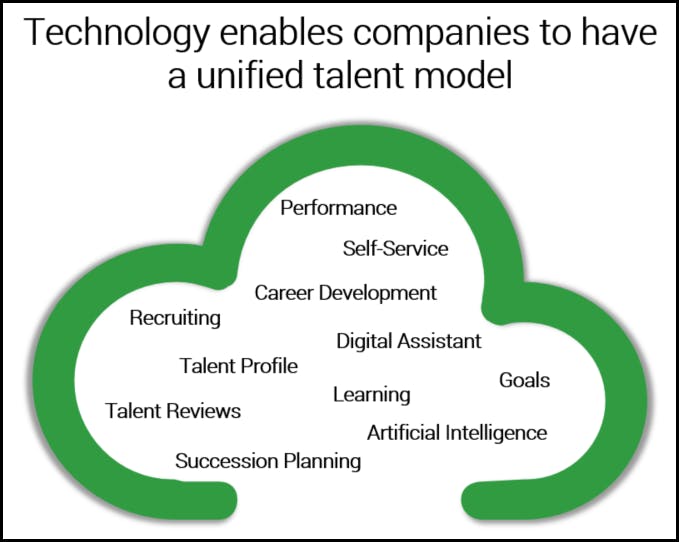
Technology and talent
Technology supports and enhances many talent management functions, whether by Oracle or another platform. Most of these functions, as noted in the diagram above, have been standard parts of the talent function for decades. Some have only recently become available through self-service functionality, digital assistant capabilities and artificial intelligence. Newer, cloud-based technologies are rapidly becoming essential for a company’s talent model to succeed.
For example, the digital assistant is a Chatbot available for employees to leverage in order to request information easily. For instance, they can find out about open positions or training opportunities within their company without having to send an email, make a phone call or search a web site. Artificial intelligence in the talent space may look like identifying internal and external candidates that qualify for current or future openings within the company.
Succession Planning is a great use case for leveraging cloud technology in talent management strategy. In the past, effective succession planning focused primarily on senior level employees. Now, technology allows companies to plan and include staff further down the organizational ladder by using real-time data that integrates with other talent and HR functions. This type of technology aids companies in identifying and analyzing top talent. It also provides space to ‘reverse engineer’ a talent search strategy on the skills and competencies desired to drive successful outcomes.
Polling results
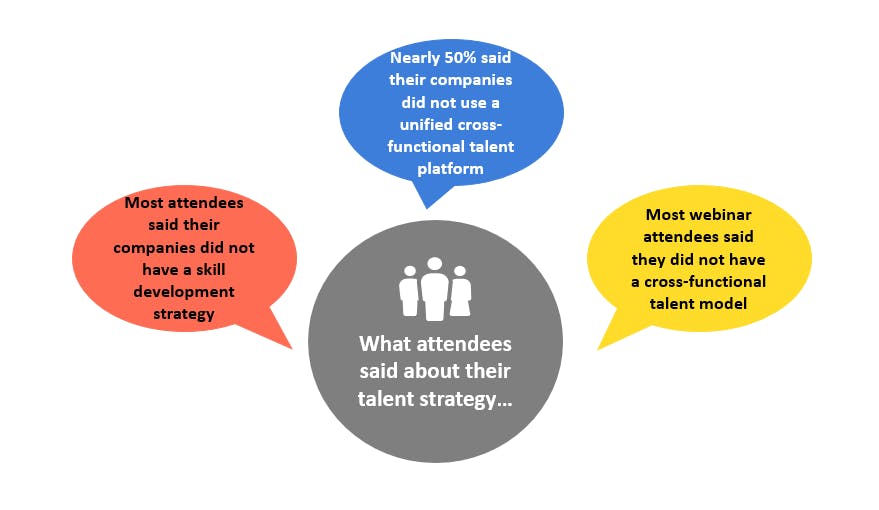
Unified talent model
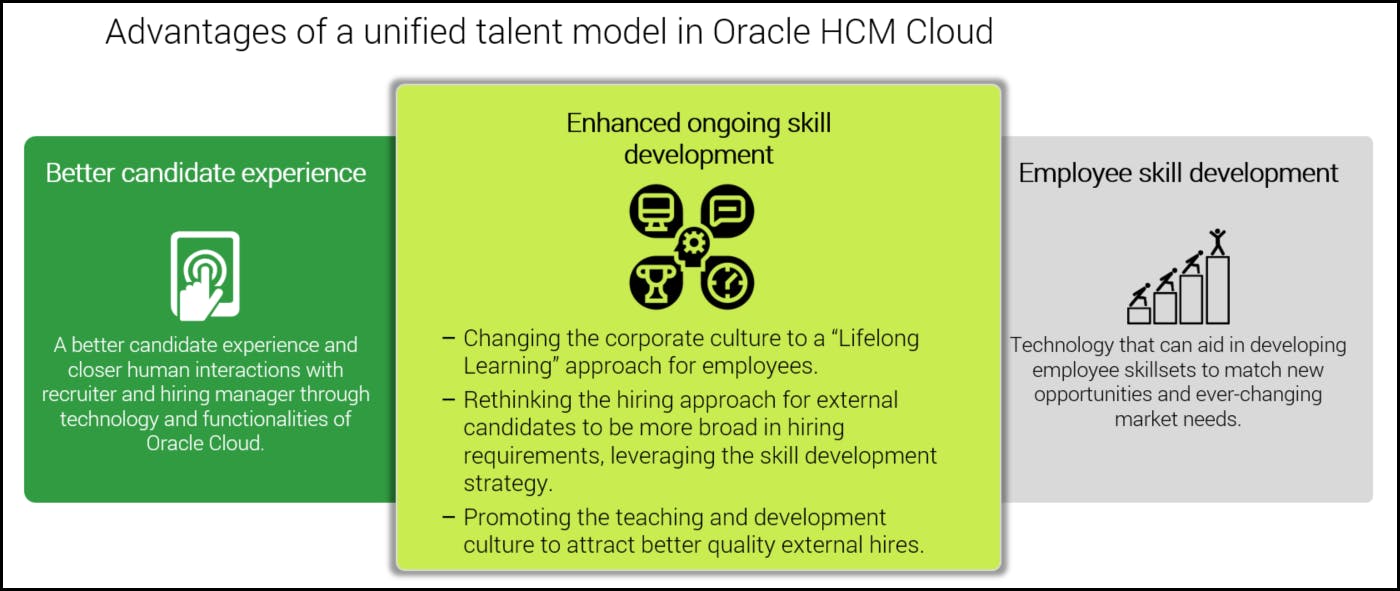
Oracle HCM Cloud is just one example of a sophisticated, unified platform that enables a cross-functional talent model. It provides companies with three core advantages – a better candidate experience, an opportunity to focus on a lifelong learning approach for employees, and capabilities that support the development of new employee skills to match market needs.
Better user interfaces, such as mobile-friendly systems, make for a better candidate experience, especially when candidates are applying for a job. The candidate experience extends beyond just the career site and its formatting. Screening questions, for instance, help candidates understand how their skills align with the company’s needs. The application process can describe to candidates what it is like to work on a particular team and for the overall organization. Incorporating social media platforms into the recruitment process also makes for a better candidate experience. Platforms like LinkedIn and Indeed, which can be tightly integrated with cloud technology, make it easier to connect and interact with potential candidates without them even needing to visit the company's website. Built out features, ultimately set by strategy but empowered via technology, are responsible for conveying corporate culture that is truly a determining factor for prospective candidates.
Lifelong learning is a commitment by employers to develop talent from within the organization on an ongoing basis, as opposed to constantly looking to other companies to find talent. Decades ago, many companies like IBM and Motorola had internal training programs. Most of these programs were cut in the 1980s as companies shifted their focus to profits, stock market valuations and quarterly returns. Wheeler noted that cutting middle management jobs in the 1980s also cut out natural mentorship roles at companies. He sees this decision directly related to the talent shortages companies are facing today. Wheeler also commented that lifelong learning is something individual employees are ultimately responsible for, but should be the co-responsibility of the managers and leaders in the organization to guide employees along certain learning paths. With cross-functional collaboration and sophisticated technology, these learning paths can be made readily available, and easily adaptable to managers and employees based on team needs and enterprise goals.
Finally, companies must be proactive in providing their employees with the right opportunities for skill development to match market needs. Organizations need to work with finance, marketing and growth teams to identify market segments where the company may want to expand. Then, the focus should shift to the internal inventory of existing skills, and investing in training and development where there are competency gaps. Jeff Haynes, director of Baker Tilly’s Oracle Cloud practice, noted that younger, growth-oriented organizations have not had the chance to incorporate a robust skill development strategy but the need to move in that direction is paramount. Cloud technology can provide real-time competency reporting and planning so the leaders of the organization can make an informed decision on how to approach the right skills development path.
Why rethink talent development?
Wheeler illustrated how the pandemic has been a catalyst in accelerating the talent and skill shortages that have been developing for years. The IBM training model of the late 20th century, for example, meant the company rarely had to hire outside the organization. This strategy increased retention, loyalty, productivity and performance. Organizations need to rethink this corporate mindset.
According to Wheeler, colleges and universities cannot expect to turn out graduates with the exact skill sets needed for entry-level jobs, so companies need to go back to assuming that responsibility. He expanded on this by saying, “the only way you are going to solve the issue is to increase the supply and the only way you are going to increase the supply is through more internal development and more skill building that is specific to the needs of industries.”
Colleges cannot provide the mentorship that the newer workforce can benefit from in the workplace. New college graduates are looking for organizations to offer them mentorship, training programs, apprenticeships, and internships. That is why organizations have an opportunity to build out their employee learning and development programs. Wheeler said people development opportunities, along with flexible work arrangements, are the two biggest incentives companies can offer in today’s competitive labor market.
Companies that are adopting a robust corporate culture around talent are earmarking a small number of jobs that absolutely have to come from experienced, external people, and then filling all other jobs with talent developed internally. Even with the ups and downs of economic times, organizations cannot decimate their recruitment department and instead should stay committed to their internal team members.
Compelling change
Companies are ready to invest in a new type of talent management model when they cannot attract the right people to fill talent gaps, their retention rate starts going down, and they cannot seem to adapt fast enough to current market conditions.
One of the best things a recruiter can hear is a candidate who takes a position and says, “I'm coming to work for you, not because you had the best offer, but because I had the best interview and recruitment experience and I have the greatest chance to succeed with your company.”
Robust, coordinated talent development programs may have fallen out of favor because the market compelled companies to focus on other things. Now, however, the market is telling companies that they can and should build a strong business case about the ROI on a unified, market-leading, technology-driven talent program.
Please contact Baker Tilly to set an appointment for a no-cost evaluation to help your team build a business case. We have helped many companies develop a strong ROI argument to start a journey on the path of a Unified Talent Model and we want to help you begin that journey today.
